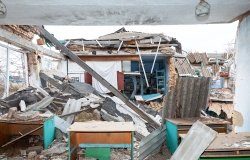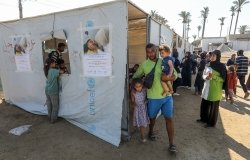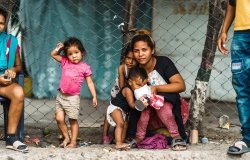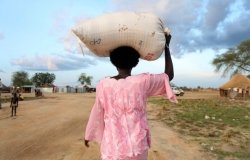
A blog of the Wilson Center
Stealing HOPE From Haiti

Haiti has few economic bright spots. One of them, a successful apparel sector, could vanish if a key US program isn’t renewed soon.
Haiti has been described as a “magnet for misery.” In recent years, it suffered a number of earthquakes, including one measuring 7.2 in 2021 that killed approximately 2,000 Haitians, and a 7.0 quake in 2010 that killed more than 200,000 people and brought over $7 billion in damages. It’s been hit by a multitude of tropical storms and hurricanes, including Hurricanes Jeanne (2004), Dennis and Wilma (2005), Tomas (2010), and Laura (2020). 2016’s Hurricane Matthew killed more than 670 people, destroyed 200,000-plus homes, and caused $2.8 billion in damages.
Some would argue that the country’s humanmade disasters have been even worse: extraordinarily corrupt public officials with little regard for everyday citizens and extraordinarily brutal criminal gangs which now control many streets and neighborhoods. More than 580,000 Haitians were displaced and 2,500 were killed or injured in gang violence in just the first half of this year. This gang activity disrupted the operations of businesses and upset the flow of goods through Haiti’s ports, roads, and airports.
It’s no wonder, then, that Haiti is the Western Hemisphere’s poorest country. It suffers from 37% inflation, a shrinking GDP, and accelerating “brain drain” of educated youth fleeing the country. Incredibly, more than 21% of Haiti’s national income now comes from remittances—money sent home by Haitians living abroad.
Those of us who have been to Haiti (I made several visits in my International Republican Institute and USAID days) know that Haiti’s problems don’t lie in the character of its everyday citizens. They’re hardworking, creative, and remarkably resilient. As close observers of the country say so often, they simply can’t catch a break.
In the coming weeks, Congress will determine whether Haitians will catch a break regarding an important economic bright spot: the growth in its modest manufacturing sector, particularly textile manufacturing. While Haiti’s economy is small, textiles have become its leading export industry and now comprise nearly 90% of the country’s manufactured exports. The US is the largest market for these products, importing nearly $774 million in textiles and apparel last year alone.
While Haiti has so often seen good intentions from outside actors like the US go awry, two important pieces of legislation in the last two decades have worked to establish a consistent trade relationship between the US and Haiti. Starting with the Haitian Hemispheric Opportunity through Partnership Encouragement Act (HOPE I) in 2006, the US Congress instituted special trade rules that gave preferential access to US imports of Haitian apparel, boosting Haitian exports by $100 million between 2005 and 2009. Following the devastating 2010 earthquake, supplementary legislation called the Haiti Economic Lift Program Act (HELP) also became law, improving US market access for Haitian apparel exports and extending the HOPE Act.
Since the HOPE I/HOPE II/HELP programs went into effect, Haiti’s apparel exports to the US have quadrupled from $231 million in 2001 to $994 million in 2021. The growing textile sector drew more foreign direct investment into Haiti, and at its peak provided between 53,000 and 57,000 jobs. In the wake of President Moïse’s assassination in 2021, gang violence spiraled out of control and damaged the capacity of the textile sector. Between 2021 and the start of 2024, the sector reportedly lost 31,000 jobs nationwide, more than half of its workforce. Multiple industrial parks specializing in textiles laid off thousands of employees, citing concerns over growing instability and insecurity.
Many of these factories are located within the Caracol Industrial Park, one of the largest such parks within the Caribbean region financed and built through a partnership between the Haitian government, the US government, and the Inter-American Development Bank. The largest employer at Caracol is a Korean manufacturer called Sae-A, which operates and employs individuals within the US as well. The lack of certainty regarding the future of HOPE/HELP has already caused Sae-A to close some factories and reduce their workforce by the thousands at Caracol. Other companies like Gap Inc., one of the largest apparel buyers in Haiti, has also pointed to the importance of renewing HOPE/HELP to help companies be able to continue working with Haiti.
When Garry Conille was sworn in as Haiti’s prime minister in early June, he was given the unenviable mission of restoring order, safety, and stability to the long suffering country. With the backing of the US, the UN, and others, Conille pledged to do whatever he could to reclaim streets and neighborhoods from the gangs. But as a former development specialist with the UN, he also knows that bringing in well-armed security forces won’t be enough: Haiti needs to find jobs for struggling families and economic opportunities that tell young people there’s a reason to stay. Haiti needs to restore and expand the bright spot that its textile industry has been in recent years. Conille recently expressed to his country’s business leaders that “the Haitian textile industry is at a critical juncture, with urgent interventions needed to address insecurity, improve working conditions, and sustain economic stability through programs like HOPE/HELP.”
Over the years, many well-meaning outsiders have offered up ideas that have simply failed to produce results. Others have offered millions and millions of dollars in assistance, especially humanitarian assistance, which the people of Haiti very much need. But humanitarian assistance is treatment, not cure. It doesn’t help Haiti move toward self-reliance and it doesn’t advance the human dignity which every person deserves. Good paying jobs are the best answer, and the HOPE/HELP programs have been an important part of getting there.
But these programs are set to expire in 2025. Because of the lead times involved with supply chains, the word is that some US brands won’t order from factories in Haiti beyond this year, and some companies are already pulling their operations out of the country. As textile companies struggle, Caracol Industrial Park will likely go under—and with it all of the investments from State, USAID, and the InterAmerican Development Bank will be lost. Congressional renewal of HOPE/HELP in 2024 is essential if these companies are going to place orders with Haitian factories in 2025.
Just like the earthquakes and hurricanes that have hurt so many in the country, many in Haiti seem to be at the mercy of forces beyond their control.
This blog was researched and drafted with assistance from Camilla Reitherman.
About the Author
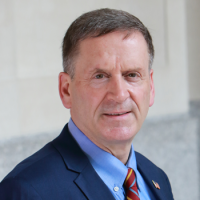

Latin America Program
The Wilson Center’s prestigious Latin America Program provides non-partisan expertise to a broad community of decision makers in the United States and Latin America on critical policy issues facing the Hemisphere. The Program provides insightful and actionable research for policymakers, private sector leaders, journalists, and public intellectuals in the United States and Latin America. To bridge the gap between scholarship and policy action, it fosters new inquiry, sponsors high-level public and private meetings among multiple stakeholders, and explores policy options to improve outcomes for citizens throughout the Americas. Drawing on the Wilson Center’s strength as the nation’s key non-partisan policy forum, the Program serves as a trusted source of analysis and a vital point of contact between the worlds of scholarship and action. Read more


